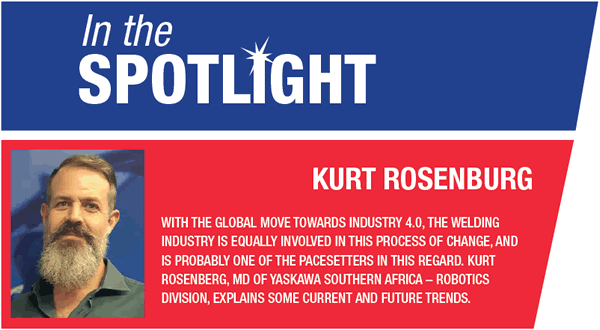Private: In the Spotlight – Kurt Rosenburg

F: Who is Kurt Rosenburg?
KR: I completed an NDip Architectural Technology at Wits Technikon in 1994, before going on to work at various international architectural, construction, interior and urban design companies over a period of 10 years.
I completed further studies in Project Management and then a PMD in Business General Management and Economics, as well as Strategic Sales Management at the Gordon Institute of Business Science (GIBS) in Johannesburg.
I joined YASKAWA Southern Africa in 2006. I have since been involved in all aspects of the business including robotic sales, internal systems development, CAD and procedures development,
among others. I then moved into the position of Sales Director.
When Terry Rosenberg, the founder of Robotic Systems SA (now YASKAWA Southern Africa) and a doyen of the robotic welding industry in South Africa, stepped down in 2016, I was appointed the new Managing Director.
For fun and relaxation, I am a PADI scuba instructor, enjoy competitive mountain biking and playing guitar.
F: How long have you been in the welding industry and why did you choose this industry?
KR: I have been in the industry for 13 years. For me, the unique challenges faced in an ever-changing and technologically hungry world, and more specifically Southern Africa, are profound, and as such, offer a vast spectrum for learning and development of people, processes and technology.
The combination of our world class YASKAWA Robotic products and capabilities, and globally accepted welding technology, open a door to provide next-level, cutting-edge welding performance to the industry.
F: What does your company do?
KR: YASKAWA delivers innovative industrial robotic solutions for virtually every industry, be it automotive, manufacturing or packaging. This includes robotic arc and spot welding, assembly,
coating, dispensing, material handling and material processing as well as robots designed for laboratory and clean room applications.
The YASKAWA Group’s global network includes business bases in 29 countries and production bases in 10 countries. It is one of the largest global manufacturers of industrial robots, with an installed base of more than 350 000 robots worldwide.
F: How did you get involved with the SAIW?
KR: Our relationship with the SAIW started many years ago. As the centre of excellence in the welding field in SA, the SAIW has always been pivotal to the industry in which both our organisations operate.
Support for welder training is paramount to support for the industry, and indirectly, critical to the support of our Robotic Welding Division. More recently though, YASKAWA Southern
Africa has been collaborating with the SAIW on the formation and establishment of a Robotic Welding Training curriculum.
This new initiative is key to providing a support platform for advancement of welding technology, by allowing new skilled, as well as advanced level candidates, access to the next level of expertise they will require when entering a very competitive job market.
F: What is your view of SAIW’s contribution to the South African welding industry?
KR: The core skills and advanced learning possibilities that the SAIW engages in and offers, is a critical component for our South African market and economic development. The change required to ensure our amazing country’s future lies heavily in the hands of the manufacturing sector.
Is the anywhere better to position yourself, than in the fundamental building phase of skills development? This is where I believe the SAIW shines – developing people that can develop an industry.
F: With the global move towards Industry 4.0, is the welding industry moving in line with this trend?
KR: YASKAWA’S Industry 4.0 concept “i³ Mechatronics” brings together classical mechatronics, information and communication technology with digital solutions such as artificial intelligence (AI), Big Data and the Internet of Things (IoT). “i3” stands for integrated – intelligent – innovative.
Relevant process and system data is collected in a scalable database in real time, analysed and learned by AI optimisation.
Visualisation is direct and comprehensible in the “YASKAWA Cockpit” software platform. The present status of every machine can be mapped concurrently in real time and correlated with other data sources, for example for coordinated predictive maintenance.
The data can also be easily be forwarded to existing ERP, MES, Big- Data or AI environments in observance of the most stringent safety standards, enabling well-founded decisions on this basis.
F: What are some of the key trends currently taking place in the industry?
KR: Efficiency is perhaps one of the key trends we see. Efficiency of design, cost, material, people and machinery. The accumulated experience and significant level of expertise South Africa has to offer, is staggering.
As such, I believe that to realise the true benefits of such a trend, industry professionals and thought leaders need to consolidate strategies and actions into a combined approach.
YASKAWA has adopted the term “Humatronics”. Although this is really just a catchphrase, the deeper meaning speaks to the need for true collaboration between humans and technology to support a world in need of solutions.
The realisation of this concept, in a multitude of industries, speaks to the need for efficiency in much of what we currently do in the industry.
F: As the technological revolution continues apace, what are some of the likely trends to be seen in the welding industry in the next two years?
KR: As we track much of what happens on a global scale, we see a continued and strong drive towards automated welding technologies. This is as a result of the fast pace and constant
increase of requirements for goods by consumers.
This is driven substantially by the automotive industry where automated welding is a non-negotiable due to the safety critical nature of the products. Many industries are following suit and
adopting these combined technologies, in order to stay ahead of the competition and provide consumers with what they want.
It then stands to reason, that the avenue the SAIW is beginning to adopt, is most definitely the right one, as it is in alignment with where the market (job and product) is heading.


